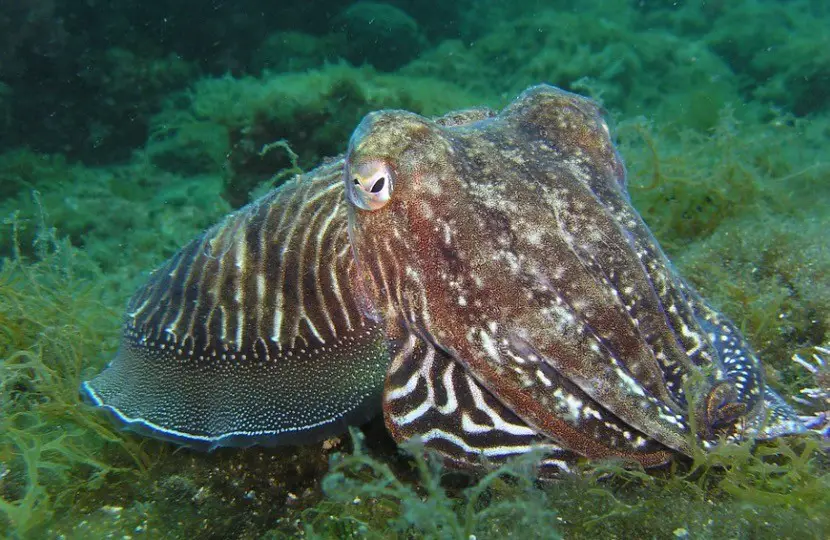Table of Contents
Giant Squid: All You Need To Know
A giant squid is a deep-sea cephalopod that belongs to the kingdom of Animalia, phylum Mollusca, and class Cephalopoda. Its genus is Architeuthis, and its species is A. dux. Its length is up to 13 m, and it weighs about 275 kg. It lives in the deep oceans, with a lifespan of 5 years.

Giant Squid Basic
A mollusc endemic to the deep water, the gigantic squid is a cephalopod species. They are secretive and seldom seen alive, but are known for their enormous size, reaching lengths of up to 43 feet (13 metres) and weighing up to 606 pounds (275 kg).
The gigantic squid is, in fact, one of the world’s biggest invertebrate species, second only to the colossal squid. The number of distinct species of gigantic squid is a point of contention. However, the most current genomic data shows that Architeuthis dux is the sole known species.

Giant Squid Description
The Giant Squid resembles several other squid species that are more often seen. They have eight arms and two larger tentacles that surround their hard beaks and radula, which is a unique feature utilised to break food into small enough bits to eat.
The mantle originates at the base of their tentacles and is flanked by two fin-like appendages that help in movement. The mantle forms a spade-like shape towards its end. Only the gigantic squid grows larger than the giant squid, with females reaching 43 feet (13 metres) and males reaching 33 feet (11 metres) (10 m). Giant squid may weigh up to 600 pounds (272 kilogrammes), a massive weight by any measure.
Giant Squid Distribution
Because giant squids live in the deep ocean, they are difficult to examine. In fact, it wasn’t until 2004 that the first photograph of a gigantic squid in the wild was captured. They are usually found in fishing nets that have been placed in deep waters. This can be found in all of the world’s seas, implying that they are ubiquitous.
Squid are frequently collected around Newfoundland, Norway, and the British Isles because the North Atlantic water is exceptionally deep. Other species of squid have been seen to make substantial diurnal vertical migrations, reaching shallow areas in the dark to hunt and then returning to deeper seas during the day.
It is unknown how deep they dwell or how close to the surface they typically travel, but based on knowledge of sperm whales, their major food, giant squid are thought to exist in seas between 980 and 3280 ft (300-1 000 m). Cephalopods, such as the giant squid, have a number of distinguishing characteristics, such as the capacity to generate ‘ink’ to confuse and repel predators.
They also have complex neurological systems and brains, which makes them very interesting to neuroscientists. They also have enormous eyes, with the gigantic and colossal squids having the biggest eyes of any species. Giant squid also have a closed circulatory system, which is a cephalopod-only trait.
Giant Squid Behavior and Ecology
Despite being one of the two biggest extant invertebrate species and a source of interest for humans for ages, little is known about it. This is because of their apparent predilection for living in extremely deep ocean settings. Other deep-water animals, such as fish, are known to be eaten by giant squid.
Other squid species, as well as smaller members of their own species, are eaten. They, like other squid species, grasp food with their tentacles, which have serrations on their ‘sucker’-like characteristics. These will entice the victim to use their strong beaks, which cover their radula, a modified tongue with tiny fangs.
Before the prey reaches the oesophagus and, eventually, the squid’s digestive tract, the radula shreds it. When gigantic squid are caught in fishing nets, they are usually found alone, implying that they are solitary creatures who hunt alone.
Sperm whales are the sole known predators of adults of the species, aside from other giant squids. When chasing squid, these predatory whales will dive hundreds of feet below the surface.
There is some indication that pilot whales eat the huge cephalopod as well, but this has not been proven. Other big animals, such as different deep-sea shark species and other deep-sea predators, will prey on juvenile giant squid.
Giant Squid Reproduction
Because of their distant location, nothing is known about the giant squid’s reproductive cycle. Copulation happens when the male transmits sperm to the female’s egg mass, but the specific method is still being disputed.
Female squid produce a large number of eggs, which she carries around with her before ‘laying’ them in various groups or ‘capsules.’ The juvenile giant squid are self-sufficient once they have hatched, feeding on nutrients in their egg sac as larvae.
They will eventually mature into juvenile squid and attain sexual maturity after approximately three years. Giant squids survive for around 5 years, despite their enormous size. The IUCN Red List of Threatened Species presently rates this species as “Least Concern.”
The present state of giant squid populations is unknown because so little is known about their life cycle and behavior.
Fun Facts About Giant Squid!
All cephalopods, including giant squid, are intriguing animals. There are plenty of interesting facts about giant squids to learn about, from their capacity to spray ink at predators to their movement technique including jet propulsion.
i. Rocket Squid
Giant squid, like other cephalopods, move by using jet propulsion. This is a particularly successful technique for these animals, since it allows them to move swiftly and accelerate quickly, maybe to evade prey.
The jet is created by the massive mantle muscles contracting, pushing water through a small funnel-like structure. The process is then repeated by pulling water into the cavity and pushing it out through a tiny respiratory system aperture.
Due to the difficulties of viewing the species in its native environment, this unusual propulsion mechanism has never been observed in gigantic squid. Given their magnitude, though, it is sure to be a spectacular and interesting show.
ii. Inked Out
Giant squid, like other squid and other cephalopods, can generate and spread an ink-like material. They’ll exude it from their ‘ink sacs,’ which are one-of-a-kind organs that create the material.
A chemical called melanin, a natural pigment found in most organisms including plants, fungi, and bacteria, turns it black. For millennia, people have utilised this ink for a variety of purposes, including in medicines and medicine.
This ability is typically utilised in conjunction with its jet propulsion skills to distract and repel predators. They may spray ink at a potential predator and then flee quickly, leaving the animal confused and unable to find the elusive invertebrate.
iii. a True Giant
In the instance of the gigantic squid, it appears that it has lived up to its moniker. In reality, the species is cited as an example of deep-sea gigantism, or abyssal gigantism, a phenomenon in which deep-sea invertebrates grow to be larger than shallow-water cousins.
It’s unclear why this phenomena happens because these environments are so difficult to examine due to their inherent inaccessibility to people. Variations in temperature, for example, have been offered as a possible reason, with the cooler temperature dictating the bigger body morphs.
Food scarcity and a lack of predators in the deep water may potentially produce selected forces that result in this size disparity. The enormous squid, at up to 43 feet (13 metres) long, is not typically capable of wrecking a ship or endangering its crew in the way that legends imply.
It is, however, one of two of the world’s biggest invertebrate species, making it a genuine giant by any standard.
Giant Squid Citations
- Potassium current in the squid giant axon. Int Rev Neurobiol . 1985;27:363-84.
- Peer-Reviewed Studies on the Effects of Anthropogenic Noise on Marine Invertebrates: From Scallop Larvae to Giant Squid. Adv Exp Med Biol . 2016;875:17-26.
- Squid (Loligo pealei) giant fiber system: a model for studying neurodegeneration and dementia? Biol Bull . 2006 Jun;210(3):318-33.







